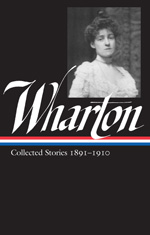From Edith Wharton: Collected Stories 1891–1910
Interesting Links
Is Edith Wharton’s The Age of Innocence the greatest novel about New York? (Reader's Almanac)
A controversial Pulitzer Prize brings Edith Wharton and Sinclair Lewis together (Reader's Almanac)
Previous Story of the Week selections by Edith Wharton
• “A Journey”
• “Kerfol”
• “Xingu”
Buy the book
 Edith Wharton: Collected Stories 1891–1910
Edith Wharton: Collected Stories 1891–1910
Two novellas (The Touchstone and Sanctuary) • 36 stories • 928 pages
List price: $40.00
Save 20%, free shipping
Web store price: $31.50
Edith Wharton loved ghost stories and included a good number of them among the more than eighty pieces of short fiction she published during her career. (We previously offered one of her creepiest tales, “Kerfol,” as a Story of the Week selection.) In 1910 she published the collection Tales of Men and Ghosts; one of its most acclaimed stories, “The Eyes,” opens when a group of men have finished sharing personal tales of “supernatural impressions.” After most members of the party leave, the host relates to his remaining two companions, including a young acolyte, an account of his own “ghost.” The story within the story, however, is a tale of psychological dread rather than an account of rattling chains and eerie moaning. To be sure, the host seems to be haunted by a spectral manifestation belonging “to a man who had done a lot of harm in his life,” but the tale reveals even more about the teller. Is Edith Wharton’s The Age of Innocence the greatest novel about New York? (Reader's Almanac)
A controversial Pulitzer Prize brings Edith Wharton and Sinclair Lewis together (Reader's Almanac)
Previous Story of the Week selections by Edith Wharton
• “A Journey”
• “Kerfol”
• “Xingu”
Buy the book
 Edith Wharton: Collected Stories 1891–1910
Edith Wharton: Collected Stories 1891–1910Two novellas (The Touchstone and Sanctuary) • 36 stories • 928 pages
List price: $40.00
Save 20%, free shipping
Web store price: $31.50
The lead character is a “confirmed bachelor,” to use the antiquated euphemism—although there is hardly anything coy about Wharton’s portrait. Motivated by selfishness and cowardice, he has convinced himself that he acts out of kindness and consideration to his acquaintances and his young “recruits.” But Wharton’s story offers a twist on the old maxim, “the road to hell is paved with good intentions.” The late Louis Auchincloss noted, “The egotism of Mrs. Wharton’s constantly recurring bachelors is brought out more effectively in ‘The Eyes’ than in any of her other short stories or novels.” The story is often described as Jamesian in style—The Turn of the Screw obviously comes to mind—and, in a recent biography of Wharton, Hermione Lee adds, “Wilde’s Dorian Gray and Edgar Allan Poe haunt this story, too, and Wharton had other examples of self-pleasing, uncommitted bachelors to draw on [from her own life].”
Notes: In the context of this story, Positivist (p. 810) describes an adherent of rigorous and testable scientific methods. Nathaniel Parker Willis (p. 814) was an early-nineteenth-century author and editor who published many works by Edgar Allan Poe, among others. Vertige de l’abîme (p. 818) is “dizziness of the abyss,” or vertigo, and bêtise (p. 820) is stupidity. Antinous (p. 820), a young man favored by the second-century Roman Emperor Hadrian, was famous for his beauty and died when he was eighteen years old, while Cherubino (p. 826) is the amorous pageboy in Mozart’s opera The Marriage of Figaro. Gautier’s axiom (p. 826) is “Nothing is truly beautiful unless it is useless.”
* * *
W e had been put in the mood for ghosts, that evening, after an excellent dinner at our old friend Culwin’s, by a tale of Fred Murchard’s—the narrative of a strange personal visitation. . . . If you don't see the full story below, click here (PDF) or click here (Google Docs) to read it—free!This selection may be photocopied and distributed for classroom or educational use.